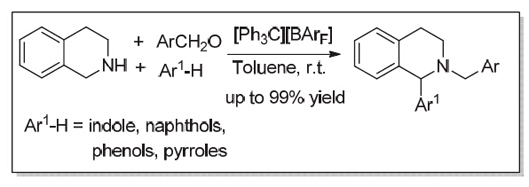| [1] (a) Shamma, M.; Moniot, J. L. The Isoquinoline Alkaloids, Chemistry and Pharmacology, Academic Press, New York and London, 1972;
(b) Hagel, J. M.; Facchini, P. J. Plant Cell Physiol. 2013, 54, 647.
[2] (a) Stöckigt, J.; Antonchick, A. P.; Wu, F.; Waldmann, H. Angew. Chem. Int. Ed. 2011, 50, 8538;
(b) Rozwadowska, M. D. Heterocycles 1994, 39, 903;
(c) Czarnocki, Z.; Siwicka, A.; Szawkalo, J. Curr. Org. Synth. 2005, 2, 301.
[3] For selected reviews of direct sp3 C—H bond activation adjacent to nitrogen atoms: (a) Campos, K. R. Chem. Soc. Rev. 2007, 36, 1069;
(b) Mitchell, E. A.; Peschiulli, A.; Lefevre, N.; Meerpoel, L.; Maes, B. U. W. Chem. Eur. J. 2012, 18, 10092;
(c) Giri, R.; Shi, B.-F.; Engle, K. M.; Maugel, N.; Yu, J.-Q. Chem. Soc. Rev. 2009, 38, 3242;
(d) Peng, H. M.; Dai, L.-X.; You, S.-L. Angew. Chem. Int. Ed. 2010, 49, 5826;
(e) Yang, L.; Huang, H. Catal. Sci. Technol. 2012, 2, 1099;
(f) Pan, S. C. Beilstein J. Org. Chem. 2012, 8, 1374;
(g) Qin, Y.; Lv, J.; Luo, S. Tetrhedron Lett. 2014, 55, 551;
(h) Zhang, Y.; Feng, B. Chin. J. Org. Chem. 2014, 34, 2406. (张艳, 冯柏年, 有机化学, 2014, 34, 2406.);
(i) Tan, M.; Gu, Y.; Luo, X.; Zhang, P. Chin. J. Org. Chem. 2015, 35, 781. (谭明雄, 顾运琼, 罗旭健, 张培, 有机化学, 2015, 35, 781.) For selected examples:
(j) Zhang, Y.; Luo, S.; Feng, B. Chin. J. Org. Chem. 2014, 34, 2249 (张艳, 罗莎, 冯柏年, 有机化学, 2014, 34, 2249.);
(k) Xia, X.; Li, L.; Liang, Y. Chin. J. Org. Chem. 2013, 33, 675. (夏晓峰, 李莲花, 梁永民, 有机化学, 2013, 33, 675.)
[4] For reviews of CDC reactions, see: (a) Li, C.-J. Acc. Chem. Res. 2009, 42, 335;
(b) Yoo, W.-J.; Li, C.-J. Top. Curr. Chem. 2010, 292, 281;
(c) Scheuermann, C. J. Chem. Asian J. 2010, 5, 436;
(d) Yeung, C. S.; Dong, V. M. Chem. Rev. 2011, 111, 1215;
(e) Liu, C.; Zhang, H.; Shi, W.; Lei, A. Chem. Rev. 2011, 111, 1780;
(f) Shi, W.; Liu, C.; Lei, A. Chem. Soc. Rev. 2011, 40, 2761;
(g) Wenlandt, A. E.; Suess, A. M.; Stahl, S. S. Angew. Chem., Int. Ed. 2011, 50, 11062;
(h) Klussmann, M.; Sureshkumar, D. Synthesis 2011, 353;
(h) Li, Y.; Ma, L.; Li, Z. Chin. J. Org. Chem. 2013, 33, 704 (李远明, 马丽娜, 李志平, 有机化学, 2013, 33, 704.)
[5] For reviews of redox-neutral approach to C-H Functionalization, (a) Seidel, D. Acc. Chem. Res. 2015, 48, 317;
(b) Peng, B.; Maulide, N. Chem. Eur. J. 2013, 19, 13274.
[6] (a) Naredla, R. R.; Klumpp, D. A. Chem. Rev. 2013, 113, 6905;
(b) Stang, P. J. In Carbocation Chemistry, Eds.: Olah, G. A.; Prakash, G. K. S., Wiley, Hoboken, NJ, 2004, pp. 1~6.
[7] (a) Norris, J. F. Am. Chem. J. 1901, 25, 117;
(b) Kehrman, F.; Wentzel, F. Chem. Ber. 1901, 34, 3815.
[8] For some recent examples, see: (a) Ludwig, M.; Hoesl, C. E.; Höfner, G.; Wanner, K. T. Eur. J. Med. Chem. 2006, 41, 1003;
(b) Sokol, J. G.; Cochrane, N. A.; Becker, J. J.; Gagné, M. R. Chem. Commun. 2013, 49, 5046;
(c) Wan, M.; Meng, Z.; Lou, H.; Liu, L. Angew. Chem. Int. Ed. 2014, 53, 13845;
(d) Chen, W.; Xie, Z.; Zheng, H.; Lou, H.; Liu, L. Org. Lett. 2014, 16, 5988;
(f) Song, G.; Wylie, W. N. O.; Hou, Z. J. Am. Chem. Soc. 2014, 136, 12209.
[9] (a) Mukaiyama, T.; Kobayashi, S.; Murakami, M. Chem. Lett. 1984, 13, 1759;
(b) Mukaiyama, T.; Kobayashi, S.; Murakami, M. Chem. Lett. 1985, 14, 447;
(c) Kobayashi, S.; Matsui, S.; Mukaiyama, T. Chem. Lett. 1988, 17, 1491;
(d) Mukaiyama, T.; Kobayashi, S.; Shoda, S.-L. Chem. Lett. 1984, 13, 907;
(e) Kobayashi, S.; Murakami, M.; Mukaiyama, T. Chem. Lett. 1985, 14, 953;
(f) Bah, J.; Franzén, J. Chem. Eur. J. 2014, 20, 1066;
(g) Bah, J.; Naidu, V. R.; Teske, J.; Franzén, J. Adv. Synth. Catal. 2015, 357, 148.
[10] Xie, Z.; Liu, L.; Chen, W.; Zheng, H.; Xu, Q.; Yuan, H.; Lou, H. Angew. Chem. Int. Ed. 2014, 53, 3904.
[11] Chen, W.; Wilde, R. G.; Seidel, D. Org. Lett. 2014, 16, 730. |
